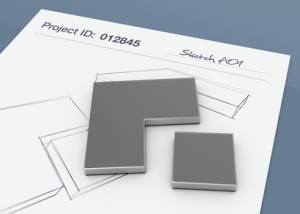Types of Prototyping for Metal Fabrication
 Types of Prototyping for Metal Fabrication
Types of Prototyping for Metal Fabrication
In preparing prototypes, it’s important to have an eye towards your eventual production plans. Whether you will be using precision stamping or fabrication could affect your design, costs, and flexibility down the line. Knowing how you plan to produce your parts will play an important role in the design constraints of the prototyping phase.
Creating quality steel products is no simple task. In order to make the best product for your client base, you have to plan and prepare. We’ve provided you with a few types of prototyping that will help you choose the right prototyping process for your project.
Sheet Metal Prototypes
When it comes to metal products, sheet metal prototyping is the key to success. If this all-important step is skipped during a major run of a key piece and alterations are required, the resulting changes, material losses, and time spent could cost tens of thousands of dollars on even a small project.
Quality steel fabrication relies on a testing and adjustment from the design phase up until production, to prevent major costs down the line. Prototyping with sheet metal allows companies to see and understand the product they are preparing.
Rapid Prototyping
Depending on your needs, different forms of rapid prototyping might be suitable for your business. For marketing models and fit checks, Stereo-lithography, or SLA, is a precise option. If what you need is a functional, durable model, then Selective Laser Sintering (SLS), which is less smooth than SLA is a great option. Fused Deposition Modeling (FDM), on the other hand, makes an excellent engineering model tool, with cost-effective, durable prototyping available. If you need elastomeric or over-mold models, Polyjet might be the option for you. And finally, CNC machining can be used when you need metal models for precision work, but these are fairly expensive.
Precision Fabrication
Metal fabrication is a great tool for prototyping, but it’s a less reliable and consistent method in metal production than stamping. Unlike stamping, if something doesn’t quite work, it isn’t a major challenge to make adjustments. The process includes controlled machining, robotic welding, and accurate cutting techniques, which means that the product is carefully handled at every step of the way. However, the technique tends to be more costly than precision stamping, and the most complex pieces aren’t a great fit for fabrication techniques.
Precision Stamping
Metal stamping can be used to make all kinds of parts, and it’s a relatively fast and cost-effective solution for the production of several identical parts. If you require the production of unique parts, metal stamping probably isn’t the ideal solution since the work and cost to set up a stamp is the same whether you are producing one or thousands of identical pieces.
Precision stamping requires a design that is set in stone, since it’s difficult to make changes to designs once the stamping tools have been created. This leads to fairly long lead times to get production started.
That said, many precision stamping companies offer prototyping services to save costs. Because of the nature of precision stamping, it’s important not to commit to a design until it’s perfect.
t

